SPACEFLIGHT UK spaceports
Magnificent Seven
The UK government is working on plans to facilitate the creation of space launch sites located within the UK, with seven sites currently preparing to apply for spaceport operating licences. BILL READ FRAeS reviews the contenders.
 Spaceport Cornwall
Spaceport Cornwall
One of the highlights of the 2014 Farnborough Air Show was the announcement of a plan from the UK government to select a site for the first commercial spaceport to be located in Britain. After the selection of a site, the schedule was to build a commercial spaceport which would begin operations by 2018. Seven years later, in 2021, we are still waiting but new plans are now under way for the creation of not one but seven spaceports around the UK.
In the original 2014 plan a total of eight sites were considered for possible selection, six of which were in Scotland. These comprised: Campbeltown Airport, Glasgow Prestwick Airport, Kinloss Barracks, RAF Lossiemouth, Stornoway Airport, RAF Leuchars, Llanbedr Airport and Newquay Cornwall Airport. In 2015, this list had been reduced to six possible sites, as RAF Lossiemouth and Kinloss Barracks were dropped due to operational defence reasons. In 2016, RAF Leuchers was also removed from the contenders. In May 2016, the competition was ended with no final selection being made.
However, recent years have seen a revival of the project. While the original plan was to select just one of the alternative spaceports, the government announced in May 2016 that it was cancelling the original bid process in favour of a licensing framework. The aim of the new system is to enable the establishment of a wide range of commercial sub-orbital and orbital operations, using both horizontal and vertical launches. Under the new rules, this means that, with the addition of sites at Shetland and Sutherland, there are now seven potential spaceport sites seeking an operator licence.
HORIZONTAL LAUNCHES HAVE THE ADVANTAGES THAT THEY COST LESS THAN VERTICAL LAUNCHES, CAN BE CARRIED OUT MORE FREQUENTLY WITH LESS FUEL AND NOISE, AND CAN BE INTEGRATED INTO EXISTING AIRPORT
In 2018 the government established the Space Growth Partnership with the aim of expanding the UK space industry. The UK’s spaceflight programme – LaunchUK – is working with a range of additional partners to establish commercial vertical and horizontal small satellite launch from UK spaceports. The government is encouraging the development of spaceports in two ways, financial and regulatory. The financial incentive has included grants totalling nearly £40m to establish commercial UK spaceports.
Meanwhile, the 2018 Space Industry Act has established the legal framework for commercial launch activity in the country. The act establishes
Secretary as regulator for UK spaceports with a primary duty to secure public safety. Regulatory functions are expected to be delegated to the UK Space Agency and the Civil Aviation Authority.
A comprehensive set of rules have been prepared which set out the requirements needed from prospective spaceport operators and launch operators. These include: licensing requirements, environmental considerations, liability and insurance, security and an accident investigation process. Work is now under way to create a final version of the rules which will, according to a statement from the Department for Transport (DfT), enable UK spaceflights to flourish while remaining safe. Once the regulatory and safety rules have been completed, legislation will be introduced which will allow both spaceport and launch operators to apply for a licence from the CAA to begin operations. To be approved for a licence, an operator will have to show that they comply with planning, safety and environmental requirements.
Technology and licences
Another issue that has had to be addressed is that of technology safeguards. Many of the planned launches from UK soil involve the use of American-made rockets and systems, the use of which requires special permission from the US to abide by ITAR and TSA controls. In June 2020, the US and UK governments signed a technology safeguards agreement detailing the procedures to ensure that export-controlled technologies on American vehicles are adequately protected when flown from British spaceports.
Horizontal and vertical
The UK sites will be used for two different types of space launches – vertical and horizontal. As their name implies, vertical launches involve the ‘traditional’ method of a rocket taking off from a launch pad – although the rockets from the UK launch sites will only be small ones. Horizontal launches involve an aircraft taking off from a conventional runway carrying a rocket which is launched while the aircraft is at a high altitude and then deploys the satellite in orbit. Horizontal launches have the advantages that they cost less than vertical launches, can be carried out more frequently with less fuel and noise, and can be integrated into existing airport facilities. The disadvantage of horizontal launches is that there are limits on the size of rockets that the aircraft can carry which can only carry smaller payloads.
Sites
Of the seven proposed spaceport sites, three will be vertical launch sites and four for horizontal launches. Five of the sites are in Scotland (Hebrides, Shetland, Sutherland, Ayrshire and Kintyre), one in North Wales and one in Cornwall. Several spaceports have already got their first customers lined up and are anticipating their first launches as soon as they have obtained operating licences.
No 1. Spaceport 1 – North Uist, Hebrides (vertical launch)
 The proposed Western Isles’ Spaceport 1 would be located at Scolpaig on the north-west coast of North Uist.
The proposed Western Isles’ Spaceport 1 would be located at Scolpaig on the north-west coast of North Uist.
In June 2019 the Western Isles local authority, Comhairle nan Eilean Siar (CnES), invested about £1m to purchase the land needed to build a site which would be used for vertical launches of small satellites. Proposals for phase 1 of the plan involve the launch of multiple ‘sounding rockets’ over a period of three years as test and evaluation for the subsequent phases. The North Uist proposal is being supported by QinetiQ, which operates the nearby Ministry of Defence Hebrides Rocket Range and is a partner in the project, together with Highlands and Islands Enterprise (HIE) and the Commercial Space Technologies consultancy.
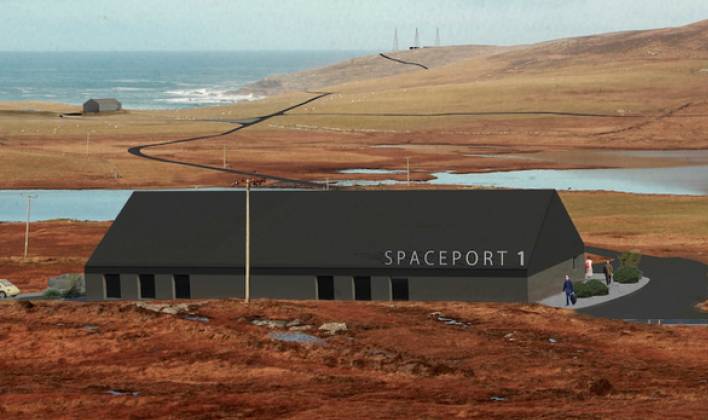 Spaceport 1
Spaceport 1
No 2. Shetland Space Centre (SSC) – Unst, Shetland Islands (vertical launch)
Another vertical launch site is being proposed for the Shetland Space Centre (SSC) located at Saxa Vord on the Lamba Ness peninsula on the UK’s most northerly island of Unst – which was also the former site of the RAF Skaw military radar site. The SSC facilities will comprise three launch pads designed to accommodate different rocket payload capacities from 30kg up to 600kg. The larger rockets will be launched from the pads located furthest east and smaller ones to the west. SSC says that it is planning for each launch company to have its own pad but will also be promoting the concept of universal launch pads for the future.

SSC is aiming to have first a ground station and then a functioning launch facility in place by the end of this year. Once the site is fully operational, SSC anticipates that there may be up to 30 rocket launches a year which could take place during the day or night. SSC states that the high latitude of Lamba Ness makes it the ideal site for launching small rockets with small satellite payloads. Such rockets are launched into either polar orbits, where the trajectory of the satellite is over both the North and South poles, or sun-synchronous orbits which are also polar but ahead of the sunrise, allowing a satellite’s solar panels to function continuously.
In February 2021, it was announced that Lockheed is planning the first rocket launch from the Shetland Space Centre (SSC) in 2022. Part of a $31m mission named UK Pathfinder, the rocket will place into orbit an orbital manoeuvering vehicle developed by Moog in the UK which will deploy six 6U CubeSats. Lockheed does not currently have a small launch vehicle compatible with the spaceport but has contracted the launch to US company ABL Space Systems which has an integrated GS0 launch system and RS1 rocket. The GS0 launch system is said to be self-contained and will not require any fixed infrastructure at the spaceport.
The Shetland Space Centre will provide a flat concrete launch pad, bulk propellant and a mission control centre. The RS1 rocket is currently still in development, with the first launch scheduled for the second quarter of this year from Vandenberg Air Force Base in California. In April it was announced that ABL Space Systems will provide Lockheed Martin with routine launches of RS1 rockets to accelerate payload technologies into orbit. Lockheed Martin will purchase up to 26 vehicles through 2025 and then up to 32 additional launches through 2029.
 Shetland Space Centre
Shetland Space Centre
In June 2020, Shetland Space Centre announced that Canadian small launch vehicle developer C6 Launch Systems plans to launch from the site. C6 is still developing a launch vehicle which will be conducting engine tests at Spaceport America in New Mexico. In February, SSC announced that it had secured a ‘further boost’ as German rocket maker HyImpulse Technologies planned to begin engine-testing and launching sub-orbital sounding rockets from Shetland this year with a view to a maiden orbital flight in 2023. Paul Riddel, Head of Comms at the Shetland Space Centre, confirmed that there were also other customers but: “until we reach formal terms with them, we are unable to say who.”
No 3. Space Hub Sutherland – Melness, Sutherland (vertical launch)

The only vertical spaceport site on the UK mainland is Space Hub Sutherland located on the A’ Mhòine peninsula, Melness, near Tongue in Sutherland on the north coast of Scotland. The site will consist of a single launchpad with an upper limit of 12 flights per year.
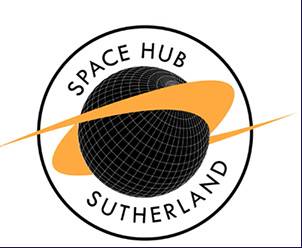
In July 2018 the UK Space Agency announced that the first customers of the Sutherland spaceport would be Lockheed Martin and small launch vehicle startup Orbex. However, Lockheed announced in October 2020 that it has received permission from the UK Space Agency to move the launch site to the Shetlands. Lockheed said that the reason behind the move was because the Sutherland site only had a single launch pad and it wanted to avoid competing with Orbex for a limited number of launches.
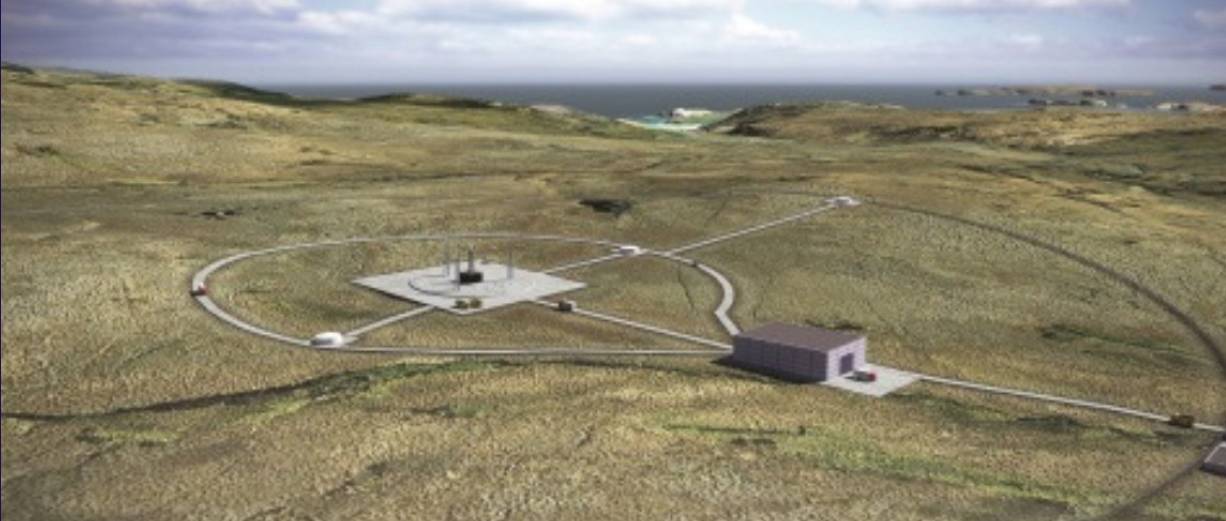 Space Hub Sutherland
Space Hub Sutherland
Orbex plans to use a small reusable rocket called Prime which it is developing to place a 150kg payload into a 500km sun-synchronous orbit. The rockets and engines are to be made at Orbex’s manufacturing plant Forres, near Inverness, using 3D printing technology. The rockets will be powered by liquid oxygen and ‘bio-propane’ fuel made from biomass.
No 4. Prestwick Spaceport – Prestwick Airport, Ayrshire (horizontal launch)
 Prestwick Spaceport
Prestwick Spaceport
A horizontal launch spaceport is also planned at Glasgow Prestwick Airport in Ayrshire where Prestwick Spaceport claims that much of the infrastructure required for horizontal space launches is already in place, including a long runway, easy accessibility, cargo-handling ability and a broad-based aerospace infrastructure surrounding the site. In addition to the air launch of satellites, proposed future uses include: micro gravity flights, hypersonic flight services and even space tourism human spaceflight.
No 5. Discover Space UK – Campbeltown Airport, Kintyre (horizontal launch)
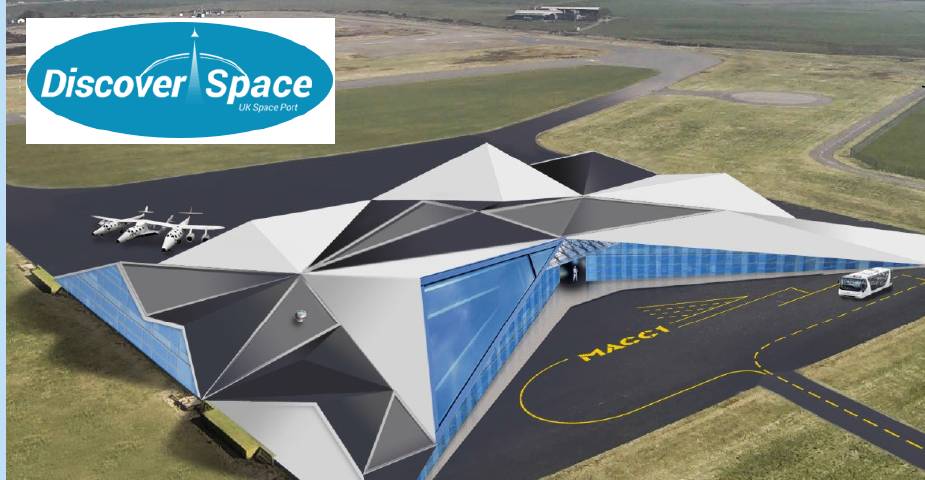 Discover Space
Discover Space
The fifth Scottish spaceport site is Campbeltown airport located in the south of the Kintyre peninsula on the west coast of Scotland. Formerly the RAF Machrihanish air base, Campbeltown airport also has a long runway (3,049m) suitable for horizontal space launches which was used for Vulcan bombers and was also a back-up emergency landing for the Space Shuttle. There is also a 2,970m parallel taxiway which could potentially also be used as a second runway. The site was purchased for £1 from the Ministry of Defence in 2012 and is now owned by the Machrihanish Airbase Community Company (MACC).
Campbeltown is promoting its spaceport ambitions under the name Discover Space UK which signed a memorandum of understanding with QinetiQ and Telespazio VEGA UK in January 2017 to investigate the potential of the site for a horizontal launch spaceport.
No 6. Snowdonia Aerospace – Llanbedr, Wales (horizontal launch)
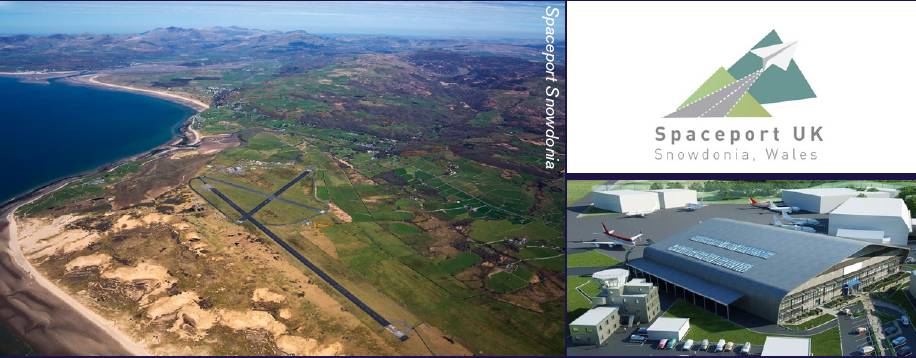 Spaceport Snowdonia
Spaceport Snowdonia
Another spaceport site is located at the former RAF airfield in Llanbedr, Gwynedd. The former military site is owned by the Welsh government but has been leased to spaceport operator Snowdonia Aerospace. Snowdonia Aerospace is hoping to launch the first sub-orbital flights over Cardigan Bay in 2022-25. The Snowdonia spaceport will also be used for testing new UAVs. The UK Space Agency has granted an additional £86,000 to Snowdonia Aerospace to test how satellite-enabled drones could be used to support healthcare in rural communities.
The spaceport has already got its first customer. Newport-based B2Space was also awarded £100,000 by the Welsh Government to use Llanbedr to examine the use of stratospheric balloons as a low-cost option for the launch of small and micro satellites into low-Earth orbit. According to B2Space, the balloons ascend to 40km carrying a ‘rockoon’ satellite launcher which then separates and carries the satellites into orbit. Balloon launches to test the feasibility of the system began in 2018 from Llanbedr and were completed in March 2020.
No 7. Spaceport Cornwall – Newquay Airport, Cornwall (horizontal launch)
 Spaceport Cornwall
Spaceport Cornwall
Meanwhile, Cornwall Newquay Airport is planning to become the only one of the seven spaceport sites to be located in England. The proposed Spaceport Cornwall plans to operate horizontal space launches in conjunction with existing commercial airline flights. Work has commenced on the Spaceport Zone 1 plan which includes the Centre for Space Technologies (CST), a large-scale airside development comprising of a 1,700m2 Space Systems Integration Facility (300m2 prep area, 400m2 cleanroom, 1000m2 integration workspace), and Operations Facility (Mission Ops Centre, Collaboration Space, Offices and Laboratories. The CST will be ready for occupation by the end of this year.
Spaceport Cornwall also has a customer interested in using the site, in the shape of Virgin Orbit which signed a partnering agreement with Cornwall Council at the 2018 Farnborough Airshow. Virgin Orbit is developing a horizontallylaunched satellite system using a modified Boeing 747-400 carrying a LauncherOne rocket which is released in flight at 35,000ft. A test flight of the system was carried out in California in November 2018 with the first launch from Cornwall anticipated for early 2022.
ATC and segregated airspace
A practical issue faced by all UK launch sites is how to keep the airspace above the sites clear for rockets to go into orbit. This is less of a problem for the more remote sites but the space site operators will need to ensure that no aircraft are flying over the sea during a launch. “The overall impact on the UK ATM network of a space launch will require deconfliction to ensure that existing airspace users are still able to operate,” John Holmes FRAeS CEng Principal Specialist, SMS Development & Commercial Space at NATS told AEROSPACE. “Operations of this nature aren’t generally compatible with civil air traffic operations and it is CAA policy for these kinds of activities to occur within separate areas which will be classified as ‘danger areas’ or other forms of segregated airspace requiring all air traffic to fly around them when declared as active. This segregated airspace will be in operation for the duration of the launch window, potentially starting when the rockets are fuelled and then continuing for take-off, descent and any potential recovery of vertical launch vehicles.”
“Segregated airspace to support launches will need to be designed and implemented by the operators, applying for permission to the CAA via the airspace change process (CAP1616) for airspace in the UK. The size of each segregated area is expected to be significant to protect third parties from harm in the event of abnormal operations, even for sub-orbital launches.”
Customised segregation
Different sized volumes of airspace could be reserved for each launch, at multiple locations for different dates and durations. In addition to the size of the segregated airspace, the impact of a launch on other airspace users will also vary depending of the duration of airspace closure, location of the launch point, time of day, aviation traffic, weather and other factors.
THE OVERALL IMPACT ON THE UK ATM NETWORK OF A SPACE LAUNCH WILL REQUIRE DECONFLICTION TO ENSURE THAT EXISTING AIRSPACE USERS ARE STILL ABLE TO OPERATE. John Holmes FRAeS CEng SMS Development & Commercial Space, NATS
“The exact details of any airspace closures for aircraft and potentially drones over the spaceport prior to the launch window are expected to be determined by the CAA in conjunction with the spaceport and launch operator,” explained Holmes. “NATS would then implement those restrictions to assure the safety and integrity of the ATM network. The required volume of segregated airspace will depend on the type of launch – a vertical rocket launch requiring a different volume of airspace from a horizontal take-off air launch. While launch points are fixed for vertical spaceports, mobile launchers from horizontal spaceports or sea launches can choose optimised locations for their desired trajectory and weather,” continued John Holmes. “The weather also onloads and offloads the UK ATM network and may cause flights onto non-optimum routings for activities that may be subject to interruption due to weather or other external factors.”
Vertical launches
“In the case of a vertical rocket launch, the size of the segregated airspace is driven by the need to protect other airspace users from abnormal operations and failures and to clear the return zones for rocket stages and fairings. A typical vertical rocket launch passes through 60,000ft feet between 80-120 seconds from lift-off with little horizontal travel down range. This restricted airspace might remain active for longer if the launch involves a stage that returns as a ballistic object. The recovery process could also increase the amount of airspace closure for an individual launch. The use of returnable vertical launched rockets could also potentially increase the number of scrubbed launches and increase the number of airspace closures as some of the current recovery technology is more vulnerable to the weather.”
Horizontal launches
For air-launched rockets, there would be two stages to consider – the horizontal take-off of the carrier aircraft and the high-altitude rocket launch. The carrier aircraft would be controlled by NATS in the same way as a normal flight – except that this aircraft would be carrying a potentially explosive payload in the form of the rocket. “NATS has a great deal of experience in managing, co-ordinating and controlling aircraft carrying hazardous cargo through our airspace,” said Holmes. “The arrangements would depend on the status of the flight conducting the horizontal launch as allocated by the CAA as part of its approval process.”
Holmes anticipates that the segregated airspace required for an air-launch rocket will not be dissimilar to that for a rocket launched vertically, saying that: “It is expected that a manoeuvring area to position the aircraft for launch would be needed in addition to the launch protection airspace. The key difference for horizontal space launches is that potentially the launches can be from different starting points on each occasion. This has implications on the types of airspace construct that can be used and mechanisms to implement that with the air traffic management system. The CAA will determine the exact airspace requirements with the launch operators.”
An extended version of this article can be viewed in the AEROSPACE Insight blog.
 Spaceport Cornwall
Spaceport Cornwall The proposed Western Isles’ Spaceport 1 would be located at Scolpaig on the north-west coast of North Uist.
The proposed Western Isles’ Spaceport 1 would be located at Scolpaig on the north-west coast of North Uist. Spaceport 1
Spaceport 1
 Shetland Space Centre
Shetland Space Centre





